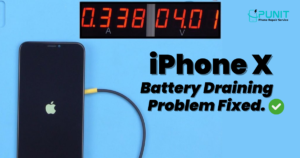iPhone X Battery Draining Problem Fixed.

The customer came to us with his iPhone X motherboard, stating that the iPhone X battery is draining rapidly with an overheating issue.
Here is the complete process for solving the iPhone X battery draining and overheating problem by Punit Telecom.
Fast battery drainage is typically caused by battery degradation or motherboard current leakage.
Even after replacing the battery, it is observed that the battery continues to drain quickly, leading to the inference that the problem is caused by motherboard current leakage.
Identifying iPhone X Power Supply Issues:
Next, we test the current of the iPhone X by powering up the motherboard with a DC power supply machine. We found that there is a small amount of current leaking in the motherboard, approximately 186mA.
If the motherboard shows current leakage after being powered up, we can measure the power supply circuits to identify the faulty part.

Identifying Issues with PP BATT VCC and PP VDD Main on iPhone X Motherboard:
First, we measure PP BATT VCC and confirm that the resistance value is normal. Next, we proceed to measure PP VDD Main. The resistance value of 29 is relatively low, indicating a damaged component on PP VDD Main.
Since the current is low, the rosin detector is unable to locate the faulty part. Therefore, we need to use a thermal imager to identify the faulty component.
Power up the PP VDD Main line on the motherboard. The temperature did not change noticeably, which means the problem is not on the outside of the motherboard. Next, we will disassemble the motherboard for further testing.
Separation Process: Safely Disconnecting iPhone X Logic Board from Signal Board:
Then, put the motherboard on a heating machine to warm it up for separating the two boards. Wait until the temperature reaches 165°C, then disconnect the logic board from the signal board.
Logic Board Diagnosis and Repair Thermal Imaging for PP VDD Main:
After the motherboard cools down, start by measuring the PP VDD Main of the logic board. The resistance value is normal when measuring the PP VDD Main of the signal board.
However, if the resistance value is abnormal, we can confirm that the faulty part is on the signal board.
Open the bitmap to confirm the position of PP VDD Main. Use the thermal imager tool to consistently monitor the signal board.
Despite no obvious change in temperature, the bitmap reveals that PP VDD Main is also present under the card reader. The faulty part is likely hidden beneath the card reader.
Next, use the thermal imager to check the back of the signal board. Notice a significant increase in temperature at the top left corner of the card reader, indicating a fault in that area. The next step is to remove the card reader.
Put some paste flux on the card reader’s bonding pad. To safeguard the plastic part, use low-temperature solder paste to control the bonding pad temperature.
Then, heat the card reader with a hot air gun set at 340 °C. Try to lift the card reader gently using a pry blade and apply heat at the same time. When the card reader loosens, carefully take it out.
Continuously monitor the card reader area with the thermal imager for any temperature fluctuations.
A significant change in temperature has been detected in this area. Based on the thermal image, the component that is heating up is the GSM module. Therefore, proceed with replacing the GSM module.
Apply some paste flux, then remove the GSM with a vertical hot air gun set at 340 °C. Next, apply some paste flux and middle-temperature solder paste to the bonding pad to lower its temperature.
Clean the bonding pad with a hot air gun and solder wick, then clean it with PCB cleaner.
Next, measure the resistance value of PP VDD Main. The resistance value has returned to normal. Proceed to install a known-good GSM.
Put paste flux on the GSM and position it. Use a vertical hot air gun at 320°C to solder it. After soldering, check the resistance value with a multimeter to ensure it is normal.
Apply a small amount of low-temperature solder paste to the bonding pad of the card reader.
Clean the bonding pad using a hot air gun and solder wick. After that, use a soldering iron and solder wick to clean the back bonding pad.
Finally, clean the area with PCB cleaner. You will notice that the pins are now clean.
Next, install the card reader by placing it in position and soldering the back bonding pad to secure it with the soldering iron.
Use a solder wick to flatten any excess tin, and be careful not to remove the tin while dragging the solder wick.
Finally, clean the bonding pad with PCB cleaner.
Next, assemble the motherboard. Place the signal board on a heating platform set at 165 °C. Put paste flux on the bonding pad. Line up the logic board with the signal board.
Once the temperature hits 165 °C, remove the motherboard. To ensure a good fit, gently press both sides of the motherboard with tweezers.
iPhone X Battery Draining Issue Fixed
Now, turn on the motherboard to test it. The current is fine. Connect the screen for testing, and the boot current is also normal.
The issue with current leakage has been resolved. Congratulations! Your iPhone X Battery Draining Problem is Solved.
Revive Your iPhone Today! Contact Punit Telecom for Expert Motherboard Repairs.
This Article is answer for Below this Questions.
Why is my iPhone X battery draining so fast?
Why My iPhone x battery health 100% but drain fast?
